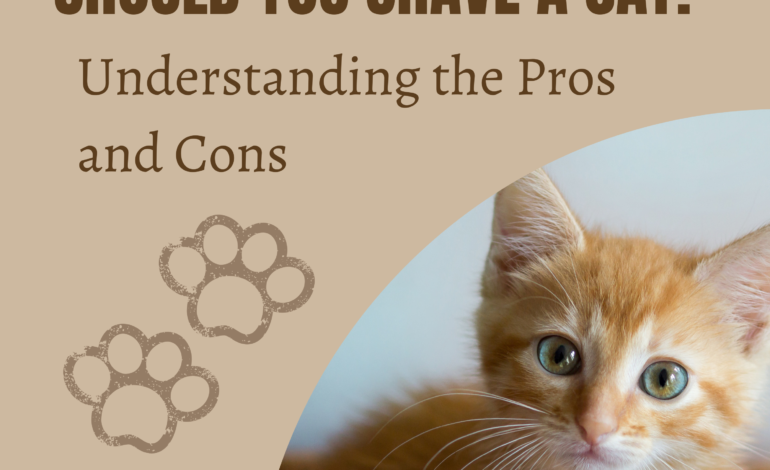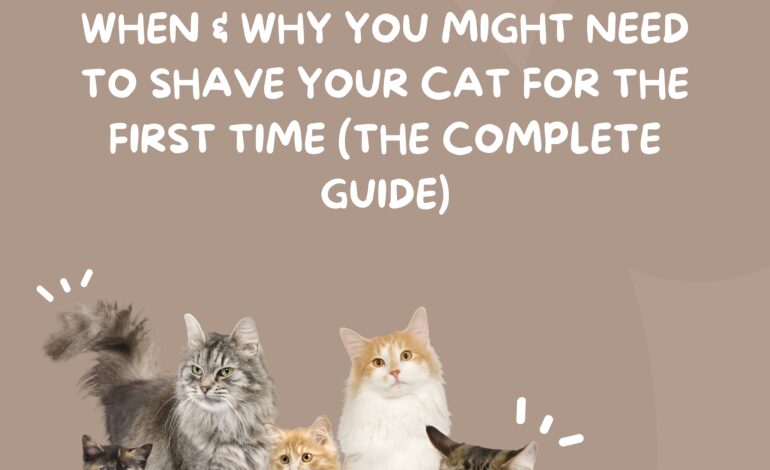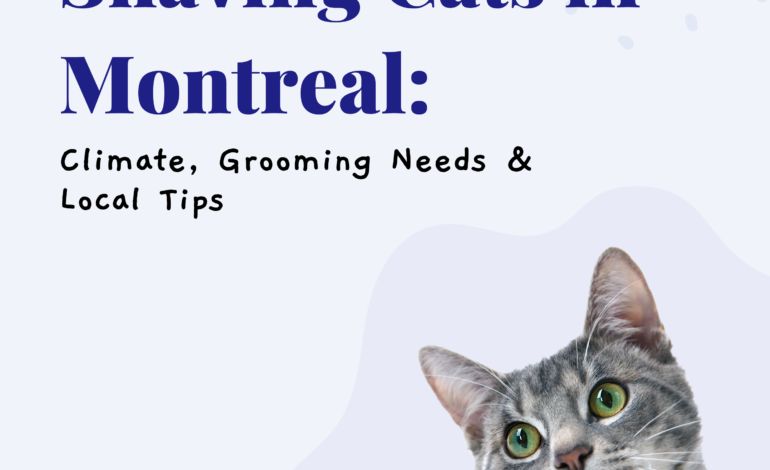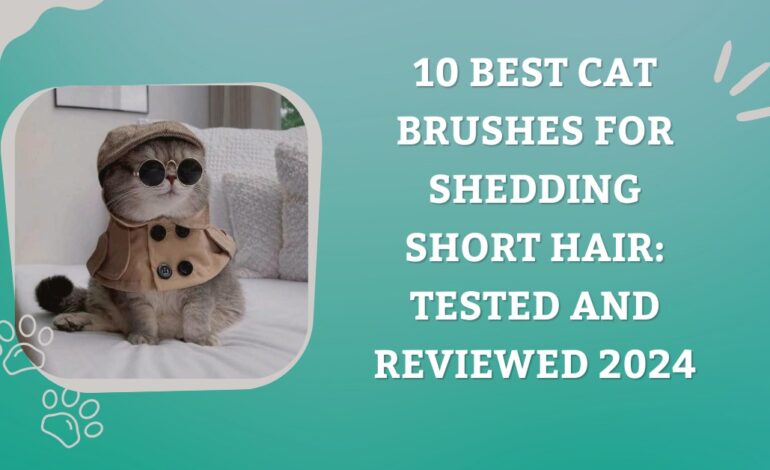Should You Shave a Cat? Understanding the Pros and Cons

Thinking about shaving your cat? While some owners believe it helps with shedding or summer heat, experts warn it can disrupt your cat’s natural protection — and even put them at risk of sunburn. Research shows fur helps channel cool air to the skin—clip it, and your cat loses that protective mechanism. Additionally, cats have thin, delicate skin (0.4 – 3.6 mm) that’s highly prone to nicks and follicle damage when shaved improperly.(1)
In this guide, it breaks down the real pros and cons of cat shaving, highlights when it might actually be necessary, and suggests safer alternatives to keep your feline comfortable and healthy.
Why Some Owners Consider Shaving Cats

- Manage heavy shedding at home. Did you know cats can spend nearly half their day grooming?. That constant licking loosens plenty of hair, and when the seasons change, shedding spikes even more studies show that daylight length (photoperiod) plays a big role in how much fur they lose. No wonder many cat parents feel shaving might be an easy fix.(2)
- Prevent or resolve painful mats. Long-haired breeds are over-represented for haircoat disorders (e.g., Persians: 12.7% haircoat disorder prevalence in a large VetCompass cohort), and tight mats can irritate skin—prompting some to opt for clip-downs in severe cases. (3)
- Reduce hairballs from self-grooming. Hairball risk rises when cats ingest more loose hair; controlled trials show diets with 11–15% total dietary fiber + psyllium increase fecal hair excretion within 14 days, supporting the logic of minimizing loose hair on the coat (usually via brushing; shaving is a more extreme step). (4)
- Heat comfort in hot weather. Some owners shave for “cooling,” but veterinary guidance notes fur assists thermoregulation and sun protection; routine summer shaving is not recommended for cooling (trims/brush-outs + environmental cooling are preferred).
- Easier treatment/monitoring of skin disease or parasites. In specific medical cases (e.g., dermatophytosis with extensive lesions or matted coats), clipping facilitates topical therapy and reduces contamination—this is a medically justified reason professionals may shave.
The Pros of Shaving Your Cat

- Matting & Tangle Prevention
Long-haired cats (e.g., Persians, Maine Coons) are highly prone to mats. In a VetCompass UK study, 12.7% of Persian cats presented with haircoat disorders, including severe matting. Shaving may be the only humane solution once mats are too tight to brush out, preventing skin sores and restricted movement. - Hairball Reduction
Cats spend 30–50% of their waking hours grooming, ingesting large amounts of hair. Clinical research shows diets supplemented with 11–15% fiber + psyllium significantly increase fecal hair excretion within 14 days, reducing hairball vomiting. By reducing loose fur on the coat, shaving (though less ideal than brushing) may indirectly lessen hairball frequency. - Improved Skin Care
Veterinary dermatology guidelines recommend clipping in cases of dermatophytosis (ringworm), flea infestations, or severe skin wounds, as it allows better topical treatment penetration and reduces contamination of the environment. - Cleaner Home
While no peer-reviewed trials measure “shed hair on sofas,” data show seasonal shedding is tied to photoperiod rather than temperature. A clip-down reduces loose fur temporarily, which some owners find beneficial for allergy management or household cleanliness. - Hygiene Support for Certain Cats
Overweight, arthritic, or elderly cats often struggle with self-grooming. Studies note obesity prevalence in pet cats is 25–35% in developed countries, meaning many cats cannot reach their hindquarters. A “sanitary shave” can reduce urine/fecal soiling, improving comfort and lowering skin infection risk.
The Cons of Shaving Cats

- Temperature Regulation Problems – Your cat’s fur is like natural climate control it helps keep them cool in summer and warm in winter. Taking it away can make it harder for them to regulate body temperature.
- Sunburn & Skin Damage – Without fur, cats are far more vulnerable to UV rays. Studies show squamous cell carcinoma (a skin cancer linked to sun exposure) makes up 15–26% of feline skin tumors.
- Risk of Cuts & Irritation – A cat’s skin is extremely thin (0.4–0.75 mm compared to a dog’s 1–2 mm), making accidental cuts from clippers a real risk if shaving is not done professionally.
- Stress & Anxiety – Up to 69% of cats show stress behaviors during handling or grooming, and shaving can amplify this, sometimes causing long-term grooming aversion.
- Uneven or Patchy Regrowth – Some cats experience post-clipping alopecia, meaning fur may take months to return or may never grow back fully, leaving exposed areas vulnerable.
- Sensory Disruption – Fur provides more than warmth — it supports tactile and sensory functions. Removing it may reduce a cat’s ability to sense its surroundings.
Shaving Cats – Pros and Cons

| Pros of Shaving Cats | Supporting Facts & Statistics | Cons of Shaving Cats | Supporting Facts & Statistics |
| Matting & Tangle Prevention | 12.7% of Persian cats presented with coat disorders (VetCompass UK). Shaving can prevent skin sores caused by mats. | Temperature Regulation Problems | Cat fur insulates in both heat & cold. Shaving disrupts this natural balance. |
| Hairball Reduction | Cats groom 30–50% of waking hours. Fiber + psyllium diets increase hair excretion in 14 days. Shaving reduces loose fur ingestion. | Sunburn & Skin Damage | Squamous cell carcinoma makes up 15–26% of feline skin tumors, often linked to UV exposure. |
| Improved Skin Care | Veterinary dermatology guidelines recommend clipping for ringworm, fleas, wounds for better treatment. | Risk of Cuts & Irritation | Cat skin is 0.4 – 0.75 mm thick (dog’s is 1–2 mm) — highly prone to clipper injuries if not done professionally. |
| Cleaner Home | Seasonal shedding is linked to light cycles. Clip-down temporarily reduces loose hair, improving home cleanliness. | Stress & Anxiety | 69% of cats show stress behaviors during grooming. Shaving can heighten anxiety or cause aversion. |
| Hygiene Support (Elderly/Obese Cats) | 25–35% of cats in developed nations are obese, making self-grooming difficult. Sanitary shaves improve comfort. | Uneven or Patchy Regrowth | Post-clipping alopecia may delay or prevent full coat regrowth. |
| — | — | Sensory Disruption | Cat fur aids tactile sensing — shaving may reduce environmental awareness. |
When Shaving May Be Necessary

- Severe Matting Beyond Brushing – In long-haired cats, mats can tighten close to the skin and cause pain, restricted movement, or even infections. If brushing or dematting tools can’t resolve it, shaving under veterinary supervision may be the only humane option.
- Medical Treatments & Surgical Prep – Shaving is standard before procedures like surgery or treating skin infections (e.g., abscesses, ringworm). Vets shave to ensure the skin is clean, accessible, and medication can be applied directly without contamination.
- Parasite Infestations – In cases of heavy flea or mite infestations, shaving can give vets clear visibility of the skin, making treatment and monitoring more effective. While not a cure on its own, it supports faster recovery alongside medication.
- Special Health Conditions – Some cats with obesity, arthritis, or mobility issues struggle to groom themselves. Under veterinary advice, partial shaving (like a “sanitary shave” around sensitive areas) can prevent hygiene problems and reduce infection risk.
Safer Alternatives to Cat Shaving
| Alternative | How It Helps |
| Regular Brushing | Prevents mats, removes loose fur, and spreads natural oils for a healthier coat. |
| Professional Grooming | Provides expert trimming, bathing, and coat maintenance with minimal stress. |
| Sanitary Trims | Keeps hindquarters clean, reducing urine/fecal soiling without full shaving. |
| Nutritional Support | Omega-3 and Omega-6 fatty acids strengthen the coat, reduce shedding, and improve skin health. |
Tips Before Deciding to Shave Your Cat
- Consult a Veterinarian or Professional Groomer – Always get expert advice to ensure shaving is safe for your cat’s health and coat type.
- Avoid DIY Full Shaving – Without proper tools and training, you risk injuring your cat’s delicate skin.
- Consider Your Cat’s Temperament – Some cats may become anxious or aggressive; in such cases, sedation in a clinical setting may be necessary.
- Use Shaving as a Last Resort – Try brushing, detangling sprays, or partial trims before opting for a full shave.
Conclusion
Before you pick up the clippers, ask yourself: is shaving truly the best option for your cat? While it can help in special cases like severe matting or medical treatments, shaving also comes with risks—from sunburn and stress to uneven coat regrowth. For most cats, the healthier choice lies in regular brushing, professional grooming, and good nutrition.
At Meow Care Hub, we’re here to help you make the right decisions for your feline’s health and happiness. Explore our expert grooming guides, product reviews, and care tips to keep your cat’s coat shining—without the risks of unnecessary shaving.
👉 Ready to give your cat the best care? Visit Meow Care Hub today for trusted grooming advice and tools.
FAQs About Cat Shaving
1. Is it OK to shave a cat?
It depends. Shaving may be necessary for severe mats or medical reasons, but it is not generally recommended for healthy cats.
2. Does shaving cats help with shedding?
Not always. While it reduces visible fur, it can sometimes cause the coat to grow back thicker. Regular brushing is usually more effective.
3. Can shaving keep my cat cool in summer?
Not necessarily. A cat’s coat actually helps regulate body temperature. Shaving can make them more vulnerable to overheating or sunburn.
4. Are there risks to shaving my cat?
Yes. Risks include cuts, skin irritation, stress, sunburn, and uneven coat regrowth.
5. What are the best alternatives to shaving a cat?
Regular brushing, deshedding tools, sanitary trims, and professional grooming services are safer options.
Resources:
- https://pets.stackexchange.com/questions/17319/how-thick-is-the-skin-of-a-cat-compared-to-the-skin-of-a-dog
- https://www.vet.cornell.edu/departments-centers-and-institutes/cornell-feline-health-center/health-information/feline-health-topics/cats-lick-too-much
- https://pmc.ncbi.nlm.nih.gov/articles/PMC6748978/
- https://pmc.ncbi.nlm.nih.gov/articles/PMC5645811/





